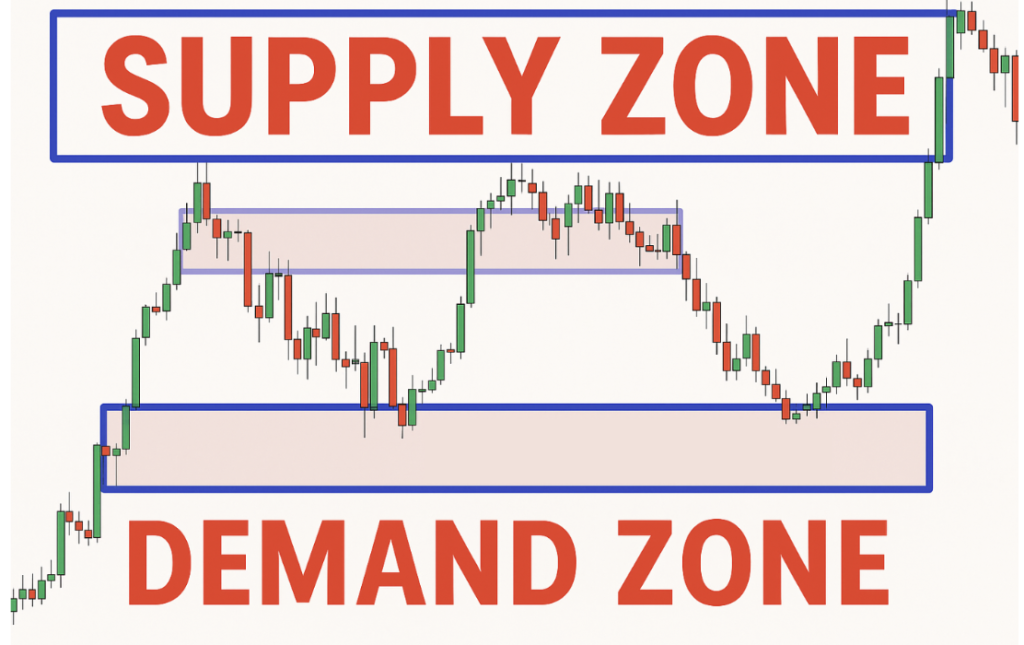Master supply and demand trading with this ultimate 2025 guide. Learn how to identify supply and demand zones, trade them effectively, and avoid common mistakes.
Supply and demand are the true forces that move the financial markets. While many traders rely on indicators or candlestick signals, professional traders and institutions often focus on supply and demand zones — areas where price reacts strongly due to imbalances between buyers and sellers.
In this guide, you’ll learn what supply and demand trading is, how to identify zones, and how to build a profitable strategy around them in 2025.

What Is Supply and Demand in Trading?
•Supply: An area where sellers exceed buyers, pushing price down.
•Demand: An area where buyers exceed sellers, driving price up.
Instead of chasing indicators, supply and demand traders focus on price imbalances and trade where institutions are likely active.
Why Supply & Demand Matters
•Works across markets: forex, stocks, commodities, crypto
•Used by institutions: big players trade liquidity, not RSI or MACD
•Clear zones: easier to spot than complex patterns
•Powerful risk/reward setups: one trade can offer high R:R if timed well
Step 1: How to Identify Supply & Demand Zones
Demand Zone
•Forms when price moves strongly upward after a consolidation base.
•Sign of buyers overwhelming sellers.
•Draw zone from the consolidation candles before the sharp rally.
Supply Zone
•Forms when price drops sharply after consolidation.
•Sign of sellers overwhelming buyers.
•Draw zone from the consolidation before the sharp drop.
Pro Tip: The stronger and faster the move away, the more powerful the zone.
Step 2: How to Trade Supply & Demand Zones
1. Mark Zones on Higher Timeframes
•Weekly & Daily charts show the strongest zones.
•Use smaller timeframes (1H/15M) for entries.
2. Wait for Price to Return to Zone
•Institutions often push price back to fill unexecuted orders.
•Patience is key — wait for retests.
3. Look for Confirmation
•Candlestick rejection (long wick, engulfing candle).
•Break of minor structure inside the zone.
4. Enter With Risk Management
•Place stop-loss just beyond the zone.
•Target opposing supply/demand zone.
•Aim for minimum 1:2 or 1:3 risk-to-reward ratio.
Step 3: Advanced Supply & Demand Concepts
Fresh vs. Tested Zones
•Fresh zone: untouched since creation = stronger reaction.
•Tested zone: already tapped multiple times = weaker.
Nested Zones
Smaller zones inside higher timeframe zones = high-probability setups.
Fakeouts & Liquidity Grabs
Smart money often pushes price slightly beyond a zone before reversing. Learn to spot stop hunts.
Multi-Timeframe Analysis
Align zones from higher (Weekly, Daily) to lower (H1, M15) for best accuracy.
Step 4: Tools to Master Supply & Demand
•TradingView: bar replay & zone drawing tools.
•MT4/MT5: custom supply & demand indicators.
•Price Action Books/Courses: focus on order flow.
•Backtesting software: test zone effectiveness before live trading.
Common Mistakes to Avoid
Trading every zone — not all zones are strong
Ignoring higher timeframe structure
Using zones without risk management
Entering too early without confirmation
Example Trading Setup (Step-by-Step)
1.Mark a fresh Daily demand zone where price rallied strongly.
2.Drop to H1 chart and wait for price to return to that zone.
3.Look for a bullish engulfing candle rejecting the zone.
4.Enter buy trade with stop just below the zone.
5.Target the next Daily supply zone.
Final Thoughts
Supply and demand trading is one of the most powerful price action methods in 2025. By understanding how institutions place orders and where liquidity lies, you can align yourself with smart money instead of trading against it.
The key is patience, precision, and discipline — only trade the strongest zones, use confirmation, and always manage risk.
Master this approach, and you’ll have a trading edge that stands the test of time.
Disclaimer: This article is for educational purposes only and does not provide financial advice. Trading forex, stocks, or futures involves high risk and can result in significant losses. Past performance is not a guarantee of future results. Always practice on a demo account before risking real money.


